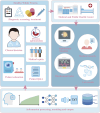Large language models in the management of chronic ocular diseases: a scoping review
- PMID: 40607211
- PMCID: PMC12213593
- DOI: 10.3389/fcell.2025.1608988
Large language models in the management of chronic ocular diseases: a scoping review
Abstract
Large language models, a cutting-edge technology in artificial intelligence, are reshaping the new paradigm of chronic ocular diseases management. In this study, we comprehensively examined the current status and trends in the application of large language models in major blinding chronic ocular diseases such as glaucoma, cataract, and diabetic retinopathy through a systematic scoping review approach. We conducted this review based on the Preferred Reporting Items for Systematic Reviews and Meta-Analyses extended to characterize the application of large language models in the field of chronic ocular diseases. The study reveals that large language models demonstrate comparable efficacy to experts in disease screening, diagnostic decision-making, personalized precision treatment recommendation, and accessibility of healthcare resources by integrating multimodal clinical data. However, the application of the technology still faces a triple challenge: (1) the limitation of model generalization ability due to the multimodal nature of clinical data; (2) the ethical controversy caused by the insufficient interpretability of algorithms; and (3) the lack of a standardized validation framework. Future directions emphasize the need for specialized model training, multimodal algorithm optimization, the establishment of a multinational multicenter clinical validation platform, and the construction of an ethical framework for dynamic regulation. Large language models are expected to evolve from an assisted decision-making tool to a core component of precision medicine for chronic ocular diseases, and ultimately to achieve an ecosystem of energy-efficient full-cycle management of chronic ocular diseases.
Keywords: chronic ocular diseases; clinical decision support; full process management; large language models; multimodal data.
Copyright © 2025 Zhang, Song, Tian, Tian, Zhang, Wang and Fan.
Conflict of interest statement
The authors declare that the research was conducted in the absence of any commercial or financial relationships that could be construed as a potential conflict of interest.
Figures
Similar articles
-
Applications of Large Language Models in the Field of Suicide Prevention: Scoping Review.J Med Internet Res. 2025 Jan 23;27:e63126. doi: 10.2196/63126. J Med Internet Res. 2025. PMID: 39847414 Free PMC article.
-
Recent Advancements in Wearable Hydration-Monitoring Technologies: Scoping Review of Sensors, Trends, and Future Directions.JMIR Mhealth Uhealth. 2025 Jun 13;13:e60569. doi: 10.2196/60569. JMIR Mhealth Uhealth. 2025. PMID: 40513095 Free PMC article.
-
Cost-effectiveness of using prognostic information to select women with breast cancer for adjuvant systemic therapy.Health Technol Assess. 2006 Sep;10(34):iii-iv, ix-xi, 1-204. doi: 10.3310/hta10340. Health Technol Assess. 2006. PMID: 16959170
-
Research status, hotspots and perspectives of artificial intelligence applied to pain management: a bibliometric and visual analysis.Updates Surg. 2025 Jun 28. doi: 10.1007/s13304-025-02296-w. Online ahead of print. Updates Surg. 2025. PMID: 40580377
-
Shared decision-making interventions for people with mental health conditions.Cochrane Database Syst Rev. 2022 Nov 11;11(11):CD007297. doi: 10.1002/14651858.CD007297.pub3. Cochrane Database Syst Rev. 2022. PMID: 36367232 Free PMC article.
References
-
- Carlà M. M., Gambini G., Baldascino A., Boselli F., Giannuzzi F., Margollicci F., et al. (2024). Large language models as assistance for glaucoma surgical cases: a ChatGPT vs. Google Gemini comparison. Graefes Archive Clin. Exp. Ophthalmol. 262 (9), 2945–2959. 10.1007/s00417-024-06470-5 - DOI - PMC - PubMed
-
- Chang L. C., Sun C. C., Chen T. H., Tsai D. C., Lin H. L., Liao L. L. (2024). Evaluation of the quality and readability of ChatGPT responses to frequently asked questions about myopia in traditional Chinese language. Digit. Health 10, 20552076241277021. 10.1177/20552076241277021 - DOI - PMC - PubMed
Publication types
LinkOut - more resources
Full Text Sources





